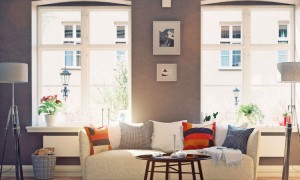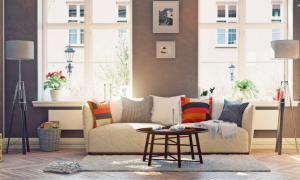At the same time, too much “boldness” can result in spaces that feel cluttered and chaotic. The good news is that by following these steps, you can incorporate vibrant hues and eye-catching motifs without going overboard.
1. Start With a Neutral Base
A great way to create symmetry in your home is to begin with a neutral palette. Whites, creams, grays and beiges serve as a calm foundation that allows colorful accents to stand out without dominating the space. A neutral-colored sofa or walls can act as a backdrop for bright throw pillows, rugs or curtains in more daring colors or styles.
2. Make Sure Your Color Scheme Flows
One of the most important aspects of interior design is making sure colors flow from room to room, ensuring a sense of cohesion. While you don’t want every space to look identical, using a consistent color palette throughout can enhance visual interest and a sense of unity. If you’re using different patterns or colors in each room, make sure they share at least one common color.
3. Pair Patterns With Solids
The trick to adding personality and visual interest is to coordinate intricate pieces with solid-colored items to give the eye a place to rest. If you’re using a bold geometric print on a rug or throw blanket, pair it with solid-colored furniture or pillows. You should also consider size and scale. If you have a dominating design on your curtains or sofa, go for smaller, subtler patterns for the other elements.
4. Limit the Number of Bold Statements
Too much design can overwhelm a space, so you should focus on mixing a few well-chosen prints and dispersing them with solid or lightly ornamented elements. A room with a plaid rug, a floral throw pillow and striped curtains can quickly become too busy. Try to stick with two to three designs at most.
5. Don’t Forget About Texture
While visual appeal is important, texture plays an equally vital role in creating a well-proportioned space. Using soft velvet cushions, woven baskets or a woolen throw adds depth to your room without the need for extra ornamentation. Incorporating natural materials like wood, stone or linen can also ground more vibrant decor, making the space feel cozy and inviting.
6. Test Elements in Small Doses
If you’re unsure about how a color or pattern will work in your space, start by trying it out in smaller areas. You can experiment with paint samples on a single wall, a bold rug or flashy artwork. Once you feel confident that the new addition complements the space, you can gradually introduce it on a larger scale.
7. Know When to Keep It Simple
If you find yourself drawn to vibrant hues and intricate patterns but worry they may overwhelm the space, consider creating a focal point rather than filling the entire room with bold choices. A feature wall or a striking piece of art can be the star of the room, with the rest of the space kept minimalistic to allow that one element to shine.
Using colors and patterns thoughtfully is about creating balance, harmony and a cohesive look that feels good to live in. By being strategic, you can embrace your unique style and personality while enjoying the beauty and impact of adventurous, forward-thinking design.






